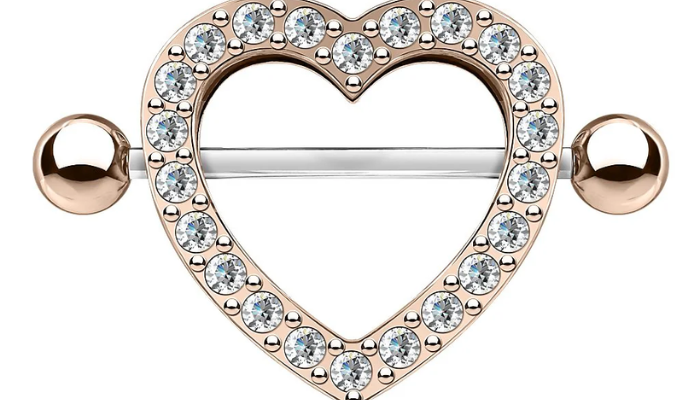Nipple barbell jewelry has become a popular choice for body piercing enthusiasts. Whether you’re considering getting a nipple piercing or are looking to switch up your existing jewelry, a nipple barbell can be a perfect option. In this comprehensive guide, we’ll walk you through everything you need to know about nipple barbells—from their types to their benefits and how to properly care for them. By the end, you’ll be armed with the knowledge to make informed decisions about this body accessory.
What is a Nipple Barbell?
A nipple barbell is a type of body jewelry specifically designed for nipple piercings. Unlike traditional studs or rings, nipple barbells consist of a straight bar that connects two decorative ends. These ends are often ball-shaped, but other designs are also available. The length and gauge of the barbell can vary depending on the anatomy of the wearer and their personal preference.
Nipple barbells come in various materials, including titanium, stainless steel, gold, and biocompatible plastics, making them suitable for different skin types and personal styles. The versatility in designs and materials allows individuals to select a nipple barbell that suits their aesthetic while ensuring comfort and safety. Whether you’re aiming for a subtle look or something more daring, there is a nipple barbell style for everyone.
Types of Nipple Barbells
There are several types of nipple barbells, each designed for different preferences and piercings. The most common types include:
- Straight Barbells: These are the most traditional nipple barbells, featuring a simple, straight design. They’re suitable for most nipple piercings and come in various lengths and thicknesses.
- Curved Barbells: As the name suggests, these barbells have a slight curve, which can add a unique aesthetic. Curved barbells are often used for piercings that require a more fitted, anatomical shape.
- Captive Bead Rings: Although technically not barbells, captive bead rings can be used as an alternative to nipple barbells. These consist of a circular bar with a bead that “captures” the ring in place, offering a different aesthetic than a straight or curved barbell.
Choosing the right type of nipple barbell depends on your personal style, comfort, and anatomy. For example, those with a more prominent or less symmetrical nipple may find a curved barbell fits better and is more comfortable.
Benefits of Nipple Barbells
Nipple barbells are not only visually striking but also offer several practical benefits to those who choose them. Here are some of the key advantages:
- Aesthetic Appeal: Nipple barbells can enhance the appearance of a piercing, offering a sleek and stylish look. The option to choose between different materials and designs allows wearers to tailor their nipple jewelry to match their personal style.
- Comfort and Security: Nipple barbells are known for their secure fit. The design ensures that the jewelry stays in place, reducing the risk of accidental displacement or irritation. The barbell shape also distributes pressure more evenly compared to rings, potentially making them more comfortable for some individuals.
- Healing Benefits: Unlike some other jewelry types, nipple barbells tend to minimize friction and irritation during the healing process. Their smooth, straight design promotes better airflow, allowing for optimal healing and reducing the risk of infection or scarring.
In addition to these benefits, nipple barbells allow for greater flexibility in customization, including options for material finishes, gemstone adornments, and more. This allows piercing enthusiasts to express their unique style while benefiting from both functionality and aesthetics.
Choosing the Right Nipple Barbell
Selecting the right nipple barbell is essential for both comfort and appearance. There are several factors to consider when choosing the perfect piece of jewelry for your nipple piercing:
- Gauge: The gauge refers to the thickness of the barbell. The most common gauges for nipple piercings range from 14g to 16g, but depending on the anatomy of the nipple, other sizes may be necessary. Choosing the correct gauge ensures a snug fit and reduces the likelihood of jewelry shifting.
- Length: The length of the nipple barbell should match the width of the nipple to prevent excessive tightness or looseness. Most nipple barbells come in lengths between 5/8” to 1” (16mm to 25mm). Choosing the correct length ensures that the jewelry is comfortable and allows for proper healing.
- Material: Body jewelry material plays a significant role in both comfort and longevity. Stainless steel is a popular choice for nipple barbells because it is durable, hypoallergenic, and easy to clean. Other materials like titanium, niobium, and gold offer additional customization options but may be more expensive.
When shopping for a nipple barbell, be sure to consider your individual piercing’s size, anatomy, and any skin sensitivities you may have. If you’re unsure, consulting a professional piercer can help you make the best choice.
Aftercare for Nipple Barbells
Proper aftercare is crucial for ensuring your nipple piercing heals well and stays free from infection. Here are some essential tips for caring for your nipple barbell after getting the piercing:
- Cleaning: Use a saline solution to gently clean the piercing site twice a day. Avoid using alcohol, hydrogen peroxide, or harsh soaps, as these can irritate the healing tissue.
- Avoiding Irritation: During the healing process, it’s essential to avoid excessive touching of the piercing. Try not to sleep on the side of your piercing, as this can cause unnecessary pressure and irritation.
- Watch for Infection: Symptoms of infection include redness, swelling, excessive pain, and pus. If you notice any signs of infection, seek advice from a professional piercer or a healthcare provider immediately.
- Healing Time: Nipple piercings typically take between 3 to 6 months to heal fully. During this time, be patient and follow proper care instructions to avoid complications.
A well-maintained nipple barbell and proper aftercare will not only ensure that your piercing heals effectively but also prolong the life of your jewelry.
Conclusion
Nipple barbells are a stylish and functional choice for those looking to express their individuality through body piercings. With a variety of styles, materials, and sizes available, there is something for everyone. By understanding the different types of nipple barbells, the benefits they offer, and the importance of proper aftercare, you can make an informed decision about your body jewelry and ensure that your piercing stays healthy and looking great. Whether you’re a first-time piercing enthusiast or a seasoned pro, a nipple barbell can be a stunning addition to your jewelry collection.
FAQs
- What is a nipple barbell?
- A nipple barbell is a type of body jewelry designed specifically for nipple piercings. It consists of a straight bar with decorative ends.
- What is the best material for nipple barbells?
- Titanium, stainless steel, and gold are popular choices due to their hypoallergenic properties, durability, and aesthetic appeal.
- How do I know what size nipple barbell to get?
- The gauge and length of the barbell should match the anatomy of your nipple. A professional piercer can help determine the ideal size.
- How long does it take for a nipple piercing to heal?
- Nipple piercings typically take 3 to 6 months to fully heal.
- Can I wear nipple barbells during the healing process?
- Yes, nipple barbells are suitable for healing piercings, but make sure they are cleaned regularly to prevent infection.
- Are nipple barbells painful to get?
- Nipple piercings can be more painful than some other piercings, but the pain is generally brief.
- How do I clean my nipple barbell piercing?
- Use a saline solution to gently clean the piercing site twice a day, avoiding harsh chemicals.
- Can nipple barbells cause infection?
- If not properly cared for, nipple piercings can become infected. Ensure proper hygiene and avoid unnecessary touching.
- What should I do if my nipple piercing gets infected?
- Seek professional medical advice immediately if you notice signs of infection, such as redness, swelling, or pus.
- Can I change my nipple barbell jewelry before it’s fully healed?
- It’s best to wait until your piercing has fully healed before changing your jewelry to avoid complications.



